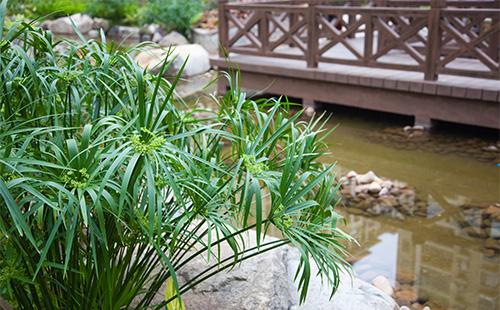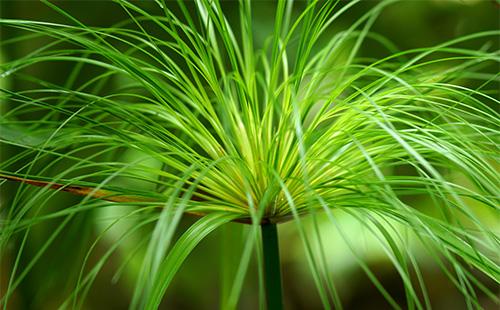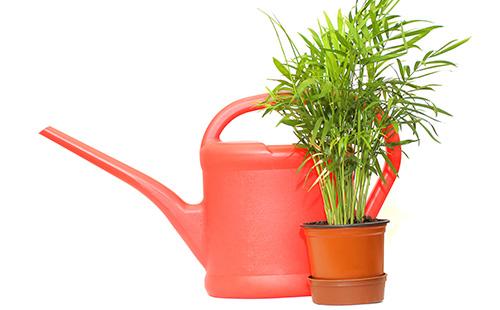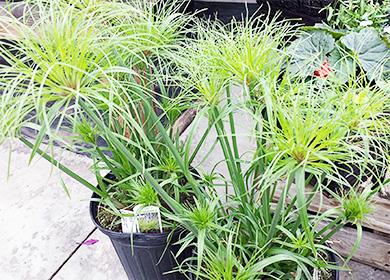The content of the article
This herbaceous perennial is also known as "sat", "russet", "Nile papyrus", "palm of cyperus". Belongs to sedge, growing in the tropics, subtropics, as well as a temperate climate zone with cool, rainy summers. Distributed on marshy lands and in coastal zones of water bodies. At first glance, cyperus is not very attractive, but in a dense landing it looks very impressive. Umbrella-shaped panicles of narrow leaves "sit" on thin stems, which looks like a dill umbrella or a small grassy palm.
The ancient Egyptians treated Cyperus with special respect, even the name of the flower is translated from Egyptian as a "gift of the river." They built boats and baskets from it, made shoes, and ate useful rhizomes.
In modern life, cyperus is a natural air purifier, a favorite pet treat. By placing cyperus in the bedroom, you can significantly improve the microclimate in the room. The main benefit of moisture-loving flowers is air humidification: the mucous membranes do not dry out, breathe easily, and in the morning we wake up fully rested.
Species features
In indoor floriculture, three main types of ornamental cyperus are grown.
- Cyperus alternate leaf (umbrella). An elegant plant of compact size with straight, long leaves combined in umbrellas. The most common indoor type of cyperus. Its height is from 35 cm to 1 m. It has small, discreet, spikelet flowers. Mostly the plant is presented in various shades of plain green. There is a variegated variety of cyperus ordinary leaf, which is recognizable by white stripes on the leaves.
- Cyperus papyrus. Its feature is straight long stems with upper rosettes of drooping, thread-like leaves and multi-flowered inflorescences.
- Tsiperus is graceful. The smallest look (no more than 50 cm) will harmoniously fit into the interior of small rooms and modest rooms.
What is the best way to organize care for cyperus?
It is clear that even the most responsible and caring florist will not recreate tropical Africa (the homeland of Cyperus) in his home. In most plants, they easily adapt to dry room air and a constant temperature of + 18-24 ° C. But how to create the most comfortable conditions for the growth of cyperus?
Location
A common mistake of beginning gardeners is to choose a place for the plant, taking into account the design features of the apartment, and not the biological requirements of the flower. Tsiperus will feel comfortable on the windowsill of a western or eastern direction. In summer, moving to a balcony, a loggia or a terrace is recommended.
Lighting
Ornamental plant loves bright light. However, we are not talking about the midday sun, which will award leaves with burns. At this time, on the contrary, shade the plant. Morning and evening sun baths are useful for cyperus. In winter, a short day, additional artificial lighting is desirable up to 14-15 hours a day. Ideal for this are fluorescent lamps.
Temperature
For the health of cyperus, a summer temperature of + 20 ° C to + 26 ° C with a regular supply of fresh air is needed. Caring for cyperus in winter involves a cool flower content at + 12-16 ° C.
Humidity
Cyperus leaves like frequent spraying and light showers, in gratitude for this, releasing new arrows. For these purposes, you need a spray gun and soft water, identical to air temperature. In winter, you need to irrigate the flower occasionally and keep it isolated from batteries and radiators.
Priming
The plant prefers light earth mixture, which can be bought in a specialized store or prepared independently. This will require garden soil, humus, peat land, sand. To save moisture, experienced growers are advised to introduce charcoal or hydrogel into the soil. Tsiperus also develops well in hydroponics.
Watering
The ability to correctly assess the plant's need for moisture is the key to its good growth. In nature, cyperus grows in water bodies and even just in water, respectively, requires a large amount of moisture. The basic rule of watering it is as follows: the roots should always be wet. In order not to forget about it, it is better to place the flower pot in a flower pot, flowerpot or ordinary container with water that slightly covers the pot. In this case, the topsoil should be sprinkled with sand or small expanded clay. A pallet with constantly wet sand or sea pebbles is also suitable. Winter watering is moderate.
Top dressing
Since ciperus develops all year, it constantly needs to be fed. In the spring and summer months, once every 15-20 days, fertilizer is applied to decorative and deciduous plants. In winter they fertilize monthly. For active flower growth, pruning of old yellowing leaves is required.

Pruning
Required variegated varieties. We are talking about a variety of cyperus Cypressus variegatus. In order not to lose its characteristic variegation, it is necessary to cut off all green shoots and green leaves.
Transfer
Young ciperus is transplanted annually in the spring. The pot needs a high, quarter-filled drainage. Its size increases as the flower grows. An adult plant is replanted only if necessary, when the roots become crowded in the old place. In order to properly transplant cyperus into another pot, use the transshipment method. For this, a lump of earth with moist, adhering soil is transferred to a new container and added to fresh, loose soil.
Choose a breeding option
It is not enough just to know how to care for cyperus, the basics of proper breeding are also important. And the grassland propagates by seeds and three more vegetative methods: umbrellas (leaf sockets), dividing the bush and cuttings.
Seed method
Specificity. For this method of cultivation, you need a long daylight, so the optimal time for planting is April-September. It is convenient to use saucers or bowls. Seeds are not buried in the soil, but are pressed tightly to the ground.
Landing technique
- Independently prepare the soil from sheet soil, peat and river sand taken equally.
- Fill the saucers with a mixture of earth.
- After sowing seeds, use a glass or film to create a “greenhouse”.
- Germinate seeds at + 18ºC, do not expose to sunlight.
- Water the soil daily with warm water, ventilate, remove condensate from the ceiling of the "greenhouse".
- Seedlings sprouted in separate small pots of three sprouts each.
- After another two months, transfer the cyperus sprouts into the containers for a couple of centimeters more (also three). Change the composition of the soil: nutrient sod land, peat and sand in a ratio of 2: 1: 1.

Cuttings
Specificity. For the vegetative method, the upper part of the shoot is used. Cuttings plant bred in the spring.
Landing technique
- Before cutting the cuttings, shorten the length of the leaves to 5 cm.
- Cut the leaf outlet from the stem so that the trunk remains with it.
- Put the cuttings in water to grow roots (appear somewhere on the 15th day).
- After three weeks, plant the cuttings in small pots.
Upside down leaf sockets
Specificity. To breed cyperus with umbrellas, one of two breeding methods is chosen. To do this, use both cut leaf sockets, and practice breeding without separating the umbrella with leaves from the mother plant.
Landing technique: method 1
- Cut the rosette with part of the shoot (about 5 cm).
- Land in the sand rosettes down. It is in them that there are growth points.
- Organize bottom soil heating from + 20 ° C to + 24 ° C.
- After the roots appear, plant in a pot.
Landing technique: method 2
- After tilting the stem, lower the umbrella into a container of water.
- Fix the layering until the roots appear.
- Separate “children” umbrellas with roots from the mother plant and plant them in separate small pots.
Dividing the bush
Specificity. For this type of transplant, a plant older than two years is suitable. At this age, it can recover quickly.
Landing technique
- At the next transplant, carefully divide the rhizome into two or three parts.
- Plant in separate bushes in different pots with prepared earthen substrate.
- Plants planted in this way grow very quickly. The main rule, how to care for cyperus after a transplant, is to ensure abundant watering.

About growing problems and their solution
A big plus of the plants that came to us from tropical latitudes is that their “native” natural insect pests are not found here, so the risk of getting infected with some overseas fly is minimized. And in general, cyperuses have good immunity, which completely however does not exclude the disease and the defeat of "domestic" pests.
Pests
With a careless attitude, cyperus is threatened by:
- thrips;
- spider mite;
- scale shield;
- mealybug;
- whitefly butterfly.
To rid the flower of parasites, you need to make a soap solution from the shavings of laundry soap and water and treat the infected plant with it. In more severe cases, special storefronts will help. Chemistry is advised to prefer organic drugs.
Disease
Cyperus is considered quite resistant to disease. They can only be provoked by care errors: “wrong” air humidity and soil condition. What can happen?
- Cyperus leaves turn yellow. The reason is a lack of moisture, dry roots. Shoots with yellow leaves are cut to the very root. Try not to make such mistakes again: the lost color of the foliage is not returned.
- Cyperus is drying. This symptom indicates low humidity.Prolonged exposure to dry air can lead to plant death. Urgent treatment consists of daily spraying, immersion of a flower pot in a container of water, and exclusion of proximity to working heating appliances.
- Cyperus is not growing. Potential reasons are a lack of lighting, the need for top dressing, and the "tightness" of a flower pot.
- Cyperus leaves curl. Such an unpleasant transformation of the leaves occurs if the flower is cold, especially at night.
Proper cultivation of cyperus at home is impossible without caring for the health of the moisture-loving Tropican during your vacation. Cyperus is almost the only indoor flower whose roots are in the water. Before leaving for a long time, water the cyperus abundantly and place it in a basin filled with water at half the height of the pot. To disinfect in water, drop a few pieces of charcoal or five to six tablets of activated charcoal.
Reviews: “The main thing is that there is always water in the pan”
A couple of times I tried to grow this flower. As already noted here, he is completely unpretentious in the care, the main thing for him is that there is always water in the pan, since this is a coastal plant. It grows quite high - about a meter, with beautiful spreading umbrellas at the apex, it looks quite exotic and reproduces very simply - with apical umbrellas, you just need to slightly cut off the leaves of the "umbrella" and put it in the water upward with the stem, since there is a point growth. After a couple of weeks, a sprout appears that can be planted in a pot. Grows fast too. However, in spite of my unpretentiousness, he did not take root with me. And the cat is to blame. This striped thug loves to eat around him! And he knows very well that this can’t be done, therefore he is robbed only at night. It is worth turning off the light, after a while there is a rustling and "chrome-chrome." Therefore, the flower could not stand it for a long time - literally in a couple of weeks, only the ends of the stems in the pot remained from it. New sprouts also did not have time to peck, as they instantly gnawed. In general, cats have an irresistible craving for this plant. By the way, it is not toxic and does not cause harm to cats. She just doesn’t have time to grow up.
But if you do not have a cat, I advise you to try to grow it, since the plant is beautiful and problem-free.Felina, http://irecommend.ru/content/pryachte-ot-kotov
Tsiperus I inherited so to speak. When we moved to this house of ours, the old tenants left several pots of flowers in it, which of course I sheltered. Among them was cyperus. Since then, I have had to deal with the problem of its reproduction several times. The best way that I know is cuttings. In this case, a rosette of leaves always acts as a stalk, which I sprinkle with earth and water it abundantly, since it must not be allowed to dry out. From one such outlet, with proper care, I get several new plants at once, which I later divide and plant in their pots.
yu8l8ya, http://www.tipsplants.ru/taxonomy/term/1090/0
Possible difficulties: Cyperus can infect a spider mite. A sign of such a lesion is the appearance of speckles on the underside of the leaves, which grow and merge. In addition, the appearance of cobwebs. The plant becomes frail with a lack of moisture. If your cyperus leaves turn yellow, then increase watering and humidity. The main reason why cyperus turns yellow is the lack of moisture in the soil and less often in the air. As a rule, if the leaves turn yellow, they cannot be restored; for this reason, these branches are pruned to the root. The plant has good growth potential and will be able to recover to its previous shape by the next season. The pests of cyperus are aphids.
Nadia http: //semeinyiforum.forum2Ч2.ru/t545-topic

